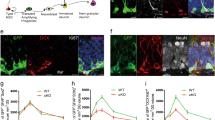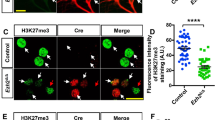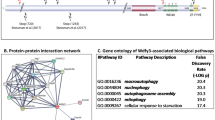Abstract
WAC is an adaptor protein involved in gene transcription, protein ubiquitination, and autophagy. Accumulating evidence indicates that WAC gene abnormalities are responsible for neurodevelopmental disorders. In this study, we prepared anti-WAC antibody, and performed biochemical and morphological characterization focusing on mouse brain development. Western blotting analyses revealed that WAC is expressed in a developmental stage-dependent manner. In immunohistochemical analyses, while WAC was visualized mainly in the perinuclear region of cortical neurons at embryonic day 14, nuclear expression was detected in some cells. WAC then came to be enriched in the nucleus of cortical neurons after birth. When hippocampal sections were stained, nuclear localization of WAC was observed in Cornu ammonis 1 – 3 and dentate gyrus. In cerebellum, WAC was detected in the nucleus of Purkinje cells and granule cells, and possibly interneurons in the molecular layer. In primary cultured hippocampal neurons, WAC was distributed mainly in the nucleus throughout the developing process while it was also localized at perinuclear region at 3 and 7 days in vitro. Notably, WAC was visualized in Tau-1-positive axons and MAP2-positive dendrites in a time-dependent manner. Taken together, results obtained here suggest that WAC plays a crucial role during brain development.




Similar content being viewed by others
Data availability
All data generated or analyzed during this study are included in this article. Further enquiries can be directed to the corresponding author.
References
Xu GM, Arnaout MA (2002) WAC, a novel ww domain-containing adapter with a coiled-coil region, is colocalized with splicing factor SC35. Genomics 79:87–94. https://doi.org/10.1006/geno.2001.6684
Zhang F, Yu X (2011) WAC, a functional partner of RNF20/40, regulates histone H2B ubiquitination and gene transcription. Mol Cell 41:384–397. https://doi.org/10.1016/j.molcel.2011.01.024
Duan Y, Huo D, Gao J et al (2016) Ubiquitin ligase RNF20/40 facilitates spindle assembly and promotes breast carcinogenesis through stabilizing motor protein Eg5. Nat Commun. https://doi.org/10.1038/ncomms12648
McKnight NC, Jefferies HBJ, Alemu EA et al (2012) Genome-wide siRNA screen reveals amino acid starvation-induced autophagy requires SCOC and WAC. EMBO J 31:1931–1946. https://doi.org/10.1038/emboj.2012.36
David-Morrison G, Xu Z, Rui YN et al (2016) WAC regulates mTOR activity by acting as an adaptor for the TTT and Pontin/Reptin complexes. Dev Cell 36:139–151. https://doi.org/10.1016/j.devcel.2015.12.019
Totsukawa G, Kaneko Y, Uchiyama K et al (2011) VCIP135 deubiquitinase and its binding protein, WAC, in p97ATPase-mediated membrane fusion. EMBO J 30:3581–3593. https://doi.org/10.1038/emboj.2011.260
Joachim J, Tooze SA (2016) GABARAP activates ULK1 and traffics from the centrosome dependent on Golgi partners WAC and GOLGA2/GM130. Autophagy 12:892–893. https://doi.org/10.1080/15548627.2016.1159368
De Santo C, D’Aco K, Araujo GC et al (2015) WAC loss-of-function mutations cause a recognisable syndrome characterised by dysmorphic features, developmental delay and hypotonia and recapitulate 10p11.23 microdeletion syndrome. J Med Genet 52:754–761. https://doi.org/10.1136/jmedgenet-2015-103069
Varvagiannis K, de Vries BB, Vissers LE (2017) WAC-related intellectual disability
Hamdan FF, Srour M, Capo-Chichi JM et al (2014) De novo mutations in moderate or severe intellectual disability. PLoS Genet. https://doi.org/10.1371/journal.pgen.1004772
Lugtenberg D, Reijnders MRF, Fenckova M et al (2016) De novo loss-of-function mutations in WAC cause a recognizable intellectual disability syndrome and learning deficits in Drosophila. Eur J Hum Genet 24:1145–1153. https://doi.org/10.1038/ejhg.2015.282
Wentzel C, Rajcan-Separovic E, Ruivenkamp CAL et al (2011) Genomic and clinical characteristics of six patients with partially overlapping interstitial deletions at 10p12p11. Eur J Hum Genet 19:959–964. https://doi.org/10.1038/ejhg.2011.71
Ito H, Morishita R, Mizuno M et al (2019) Rho family GTPases, Rac and Cdc42, control the localization of neonatal dentate granule cells during brain development. Hippocampus 29:569–578. https://doi.org/10.1002/hipo.23047
Nishikawa M, Ito H, Noda M et al (2022) Expression analyses of Rac3, a rho family small GTPase, during mouse brain development. Dev Neurosci 44:49–58. https://doi.org/10.1159/000521168
Nishikawa M, Ito H, Noda M et al (2021) Expression analyses of PLEKHG2, a Rho family-specific guanine nucleotide exchange factor, during mouse brain development. Med Mol Morphol 54:146–155. https://doi.org/10.1007/s00795-020-00275-1
Goto N, Nishikawa M, Ito H et al (2023) Expression analyses of Rich2/Arhgap44, a Rho family GTPase-activating protein, during mouse brain development. Dev Neurosci 45:19–26. https://doi.org/10.1159/000529051
Ito H, Morishita R, Noda M et al (2020) Biochemical and morphological characterization of SEPT1 in mouse brain. Med Mol Morphol 53:221–228. https://doi.org/10.1007/s00795-020-00248-4
Joachim J, Jefferies HBJ, Razi M et al (2015) Activation of ULK kinase and autophagy by GABARAP trafficking from the centrosome is regulated by WAC and GM130. Mol Cell 60:899–913. https://doi.org/10.1016/j.molcel.2015.11.018
Joachim J, Tooze SA (2018) Control of GABARAP-mediated autophagy by the Golgi complex, centrosome and centriolar satellites. Biol Cell 110:1–5. https://doi.org/10.1111/boc.201700046
Barnby G, Abbott A, Sykes N et al (2005) Candidate-gene screening and association analysis at the autism-susceptibility locus on chromosome 16p: evidence of association at GRIN2A and ABAT. Am J Hum Genet 76:950–966. https://doi.org/10.1086/430454
Martin CL, Duvall JA, Ilkin Y et al (2007) Cytogenetic and molecular characterization of A2BP1/FOX1 as a candidate gene for autism. Am J Med Genet Part B Neuropsychiatr Genet 144B:869–876. https://doi.org/10.1002/ajmg.b.30530
Sebat J, Lakshmi B, Malhotra D et al (2007) Strong Association of De Novo Copy Number Mutations with Autism. Science (80-) 316:445–449. https://doi.org/10.1126/science.1138659
Hamada N, Ito H, Iwamoto I et al (2013) Biochemical and morphological characterization of A2BP1 in neuronal tissue. J Neurosci Res 91:1303–1311. https://doi.org/10.1002/jnr.23266
Acknowledgements
We thank Mses. Noriko Kawamura and Nobuko Hane for technical assistance. This work was supported in part by Japan Society for the Promotion of Science (JSPS) KAKENHI Grant-in-Aid for Scientific Research (B) (Grant Number JP22H03049), Grant-in-Aid for Challenging Exploratory Research (JP22K19498), Grant-in-Aid for Scientific Research (C) (JP19K07059), Grant-in-Aid for Research Activity Start-up (JP20K22888), and Grant-in-Aid for Early-Career Scientists (JP21K15895).
Author information
Authors and Affiliations
Corresponding author
Ethics declarations
Conflict of interest
All authors have no conflict of interest.
Additional information
Publisher's Note
Springer Nature remains neutral with regard to jurisdictional claims in published maps and institutional affiliations.
Supplementary Information
Below is the link to the electronic supplementary material.
Rights and permissions
Springer Nature or its licensor (e.g. a society or other partner) holds exclusive rights to this article under a publishing agreement with the author(s) or other rightsholder(s); author self-archiving of the accepted manuscript version of this article is solely governed by the terms of such publishing agreement and applicable law.
About this article
Cite this article
Nishikawa, M., Matsuki, T., Hamada, N. et al. Expression analyses of WAC, a responsible gene for neurodevelopmental disorders, during mouse brain development. Med Mol Morphol 56, 266–273 (2023). https://doi.org/10.1007/s00795-023-00364-x
Received:
Accepted:
Published:
Issue Date:
DOI: https://doi.org/10.1007/s00795-023-00364-x




